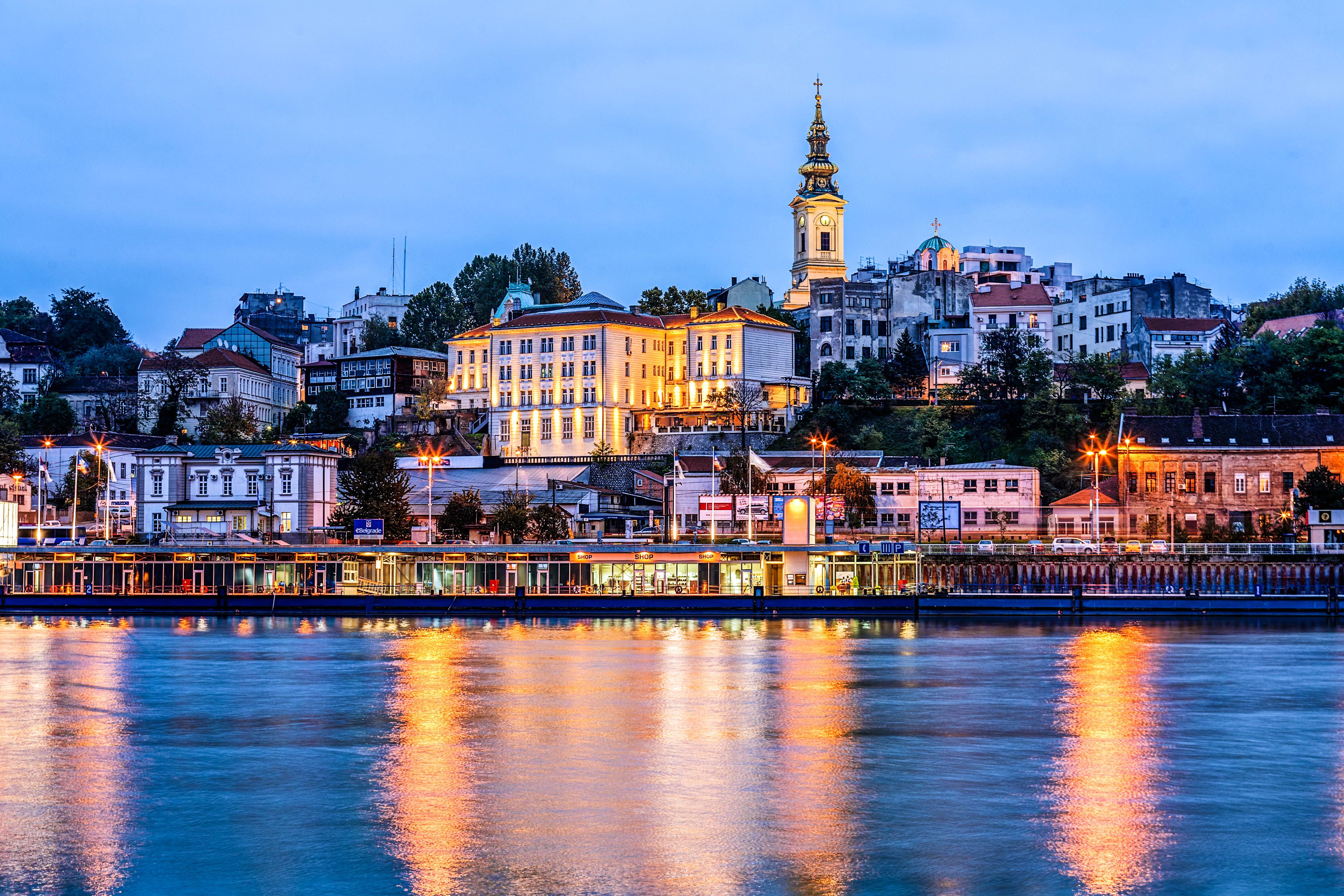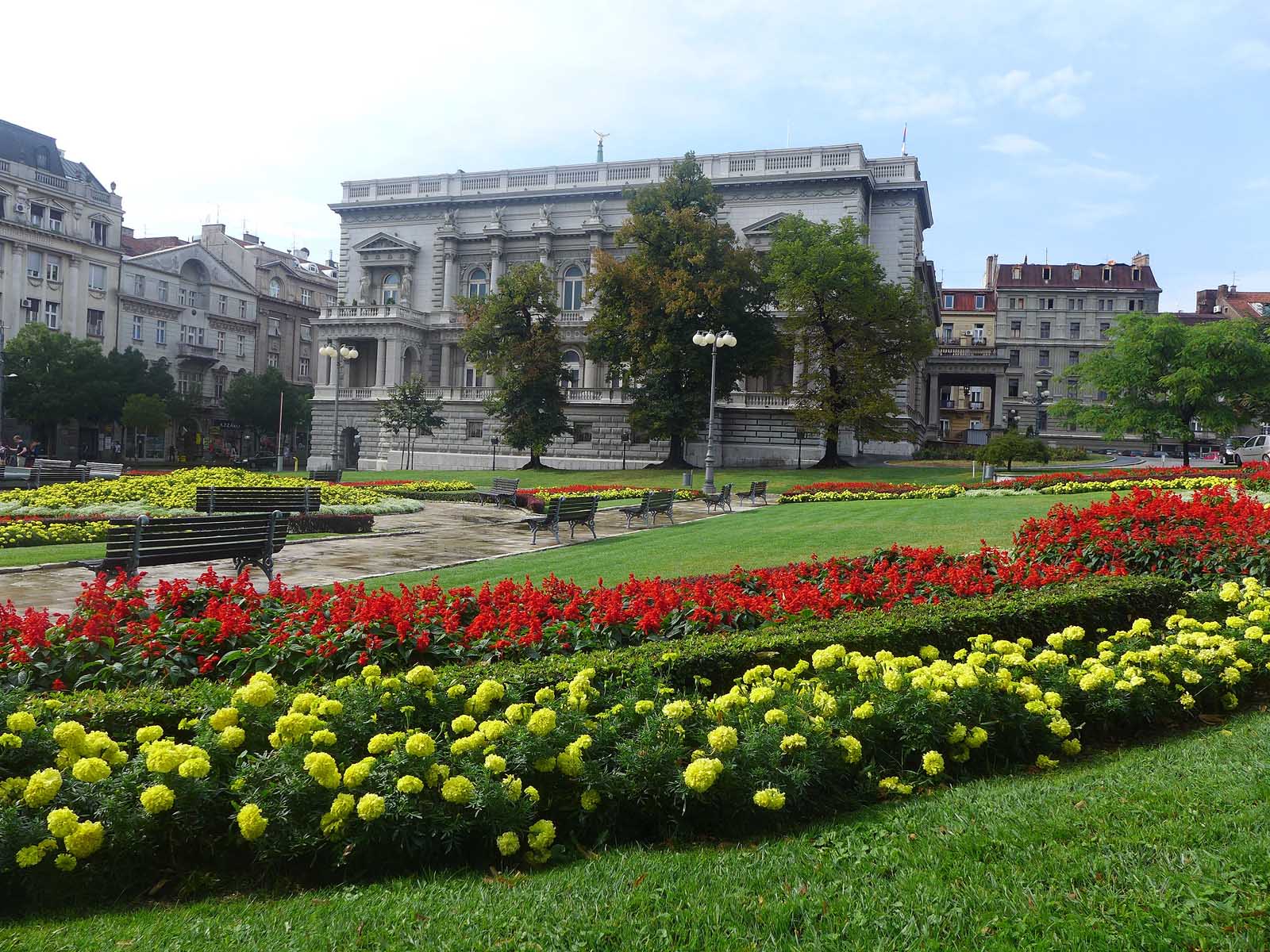

贝尔格莱德(塞尔维亚语:Београд,意为“白城”),欧洲国家塞尔维亚首都和最大城市,以及当年南斯拉夫联邦时期的总首都。贝尔格莱德市位于塞尔维亚北部萨瓦河和多瑙河汇合处,此处也是潘诺尼亚平原和巴尔干半岛的相遇处。贝尔格莱德市内共有人口123万,整个行政区范围内的人口达到近170万,是原南斯拉夫地区最大的城市。
贝尔格莱德地区最早的人类居住出现在公元前4800年温查文明时期。凯尔特人于公元前3世纪征服了这一地区,并将其命名为Singidunum,[5] 后被罗马帝国占领[6] [7]。
公元520年,斯拉夫人占领了这一地区。此后它在拜占庭帝国、法兰克王国、保加利亚王国和奥匈帝国之间几次易手。城市的斯拉夫语名字Beligrad(字面意思为“白城”)第一次被提及是在878年。1284年,贝尔格莱德第一次成为塞尔维亚斯雷姆王国的首都。此后,它还先后成为塞尔维亚(1404年-1918年、2006年-)、南斯拉夫(1918年-2003年)首都以及塞尔维亚和黑山的行政、立法首都(2003年-2006年)[8]。
贝尔格莱德是塞尔维亚唯一的直辖市[9],被分为17个自治市,每一个都拥有自己的地方委员会[10]。贝尔格莱德占塞尔维亚总面积的3.6%,约21%(不包括科索沃自治省)的塞尔维亚人居住在该市[11]。贝尔格莱德是塞尔维亚的经济、文化、教育和科技中心。
Belgrad (serbisch Београд/Beograd [], übersetzt „weiße Stadt“, daher der altertümliche Name Griechisch Weißenburg), ist die Hauptstadt der Republik Serbien. Die Stadt gliedert sich in zehn Stadtgemeinden und sieben Vorstadtgemeinden. Die Kernstadt besitzt eine Fläche von 359,96 km², die umgebenden Vorstadtgebiete 2862,72 km², wobei die Fläche einiger Gemeinden teilweise zur Kernstadt und teilweise zur Vorstadt gehört. Zusammen bilden sie den Okrug Beograd mit 1,71 Millionen Einwohnern (Zensus 2011) und gehört somit zu den größten Metropolregionen in Südosteuropa. Mit 1.233.796 Einwohnern[1] ist sie außerdem die serbische Primatstadt.
Mit seinen Universitäten, Hochschulen und wissenschaftlichen Einrichtungen stellt Belgrad das überragende Bildungszentrum und mit zahlreichen Verlagen, Rundfunk- und Fernsehanstalten sowie Tages- und Monatszeitungen auch das dominierende Medienzentrum des Landes. Belgrad ist Sitz der Serbisch-Orthodoxen Kirche und Residenz des Serbischen Patriarchen. Das größte christliche Gotteshaus der Balkanhalbinsel, die Kathedrale Hl. Sava, steht in Belgrad.
Dank der Lage an der Mündung der Save in die Donau am südöstlichen Rand der Pannonischen Tiefebene und an der Nordgrenze der Balkanhalbinsel ist die Stadt Dreh- und Angelpunkt für den Verkehr zwischen Mittel- und Südosteuropa. In der regionalen Vernetzung der Verkehrswege ist es Sitz des Sekretariats für Transport der Länder im Westbalkan.[2][3] Daher wird Belgrad oft auch als Tor zum Balkan bezeichnet. Wahrzeichen Belgrads ist die in der Geschichte häufig umkämpfte, über der Save-Mündung in die Donau thronende Festung von Belgrad. In der Nähe befindet sich die historische Universitäts-Sternwarte und jenseits des Flusses (Novi Beograd) das 1977–1979 erbaute Sava Centar, das größte Kongresszentrum aller Balkanländer.
Belgrad war erstmals zu Anfang des 15. Jahrhunderts Hauptstadt der mittelalterlichen Serbischen Herrscherdynastien und ist seit dem 19. Jahrhundert Residenzstadt Serbiens. Im 20. Jahrhundert war es die Hauptstadt des Königreichs Jugoslawien und des sozialistischen Jugoslawien. Durch die jugoslawische Ablehnung sowjetischer Hegemonie und Stalinismus und als Versammlungsort der Blockfreien war Belgrad in der Zeit des Kalten Krieges ein bedeutendes politisches Zentrum.
Belgrade (/ˈbɛlɡreɪd/ BEL-grayd; Serbian: Beograd / Београд, meaning "white city", Serbian pronunciation: [beǒɡrad] (![]() listen); names in other languages) is the capital and largest city of Serbia. It is located at the confluence of the Sava and Danube rivers, where the Pannonian Plain meets the Balkans.[7] The urban area of the City of Belgrade has a population of 1.23 million, while nearly 1.7 million people live within its administrative limits.[5]
listen); names in other languages) is the capital and largest city of Serbia. It is located at the confluence of the Sava and Danube rivers, where the Pannonian Plain meets the Balkans.[7] The urban area of the City of Belgrade has a population of 1.23 million, while nearly 1.7 million people live within its administrative limits.[5]
One of the most important prehistoric cultures of Europe, the Vinča culture, evolved within the Belgrade area in the 6th millennium BC. In antiquity, Thraco-Dacians inhabited the region and after 279 BC Celts conquered the city, naming it Singidūn.[8] It was conquered by the Romans during the reign of Augustus, and awarded city rights in the mid-2nd century.[9] It was settled by the Slavs in the 520s, and changed hands several times between the Byzantine Empire, Frankish Empire, Bulgarian Empire and Kingdom of Hungary before it became the capital of Serbian king Stephen Dragutin (1282–1316). In 1521, Belgrade was conquered by the Ottoman Empire and became the seat of the Sanjak of Smederevo.[10] It frequently passed from Ottoman to Habsburg rule, which saw the destruction of most of the city during the Austro-Ottoman wars. Belgrade was again named the capital of Serbia in 1841. Northern Belgrade remained the southernmost Habsburg post until 1918, when the city was reunited. As a strategic location, the city was battled over in 115 wars and razed 44 times.[11] Belgrade was the capital of Yugoslavia from its creation in 1918.
Belgrade has a special administrative status within Serbia[12] and it is one of five statistical regions of Serbia. Its metropolitan territory is divided into 17 municipalities, each with its own local council.[13] The city of Belgrade covers 3.6% of Serbia's territory, and around 24% of the country's population lives within its administrative limits.[5] It is classified as a Beta-Global City.[14]
Belgrade (en serbe cyrillique : Београд ; en serbe latin : Beograd) est la capitale et la plus grande ville de Serbie. Au recensement de 2011, la ville intra muros comptait 1 233 796 habitants et, avec le district dont elle est le centre, appelé Ville de Belgrade (Град Београд/Grad Beograd), 1 659 440 habitants3.
Belgrade est l'une des plus anciennes cités d'Europe, avec une histoire qui s’étend sur plus de 7 000 ans. Selon les historiens, on évalue la destruction de la ville entre 28 et 33 fois, sa position stratégique en Europe étant son bonheur et son malheur, d'où les vers du XVe siècle de Constantin le philosophe, « Pleure ville blanche, le noir de tes deuils »4. Les premières traces de présence humaine dans la région remontent à la Préhistoire et à la culture de Vinča. Historiquement, Belgrade est l’antique cité de Singidunum, colonie romaine située dans la province de Mésie. Le nom slave Beograd apparaît pour la première fois le 16 avril 878, dans une épître envoyée par le pape Jean VIII au prince Boris Ier de Bulgarie. Il a pour signification la « ville blanche ». Au fil de son histoire mouvementée, Belgrade a été conquise par 40 armées : elle a été romaine qui l'a surnommé « La colline aux méditations »5, byzantine, hongroise, serbe, ottomane puis capitale de la Serbie officiellement indépendante de la Sublime Porte en 1878.
Aujourd'hui, Belgrade dispose d'un statut qui la dote d'une assemblée et d'un gouvernement particuliers, à l'instar des districts de Serbie6. Sa zone métropolitaine, appelée « district de Belgrade » ou « ville de Belgrade », est divisée en 17 municipalités qui possèdent toutes leur propre conseil local7. Le district de Belgrade couvre ainsi 3,6 % du territoire de la Serbie et abrite 21 % de la population du pays (hors Kosovo). Belgrade est le centre économique de la Serbie, mais aussi la capitale de la culture serbe et celui de l'éducation et des sciences du pays.
Belgrado (AFI: /belˈɡrado/[2][3]; in serbo Бeoгpaд, Beograd?) è la capitale della Serbia e, fino al 1992, della Jugoslavia.
Si trova nell'ex provincia della Serbia centrale, nel punto di confluenza tra i fiumi Sava e Danubio, dove il territorio della Penisola Balcanica incontra la Pannonia. È una delle città più antiche d'Europa.
Con una popolazione di 1.233.796 abitanti, quella di Belgrado è l'area metropolitana più popolata dell'ex Jugoslavia, nonché la terza nell'Europa sudorientale, dopo quelle di Atene e di Bucarest; l'estensione superficiale dell'area urbana occupa il 3,6% del territorio della Serbia e vi risiede il 21% della popolazione serba (escludendo quella della provincia del Kosovo[4]).
La città possiede uno status che le conferisce una maggiore autonomia rispetto agli altri centri urbani della Serbia. È divisa in 17 comuni[5], dotati anch'essi di una propria autonomia organizzativa[6]. Belgrado non solo è la capitale economica e finanziaria della Serbia, ma anche culturale e scientifica, ed è uno dei principali luoghi turistici della nazione.
Nel 4800 a.C. circa, nell'area dell'attuale città di Belgrado si sviluppò la cultura Starčevo. Il medesimo territorio fu occupato alcuni secoli dopo dal popolo dei Vinča. Nel III secolo a.C. i Celti fondarono un villaggio nella zona che oggi è il centro storico di Belgrado, che fu, successivamente, conquistato dai Romani, che gli diedero il nome di Singidunum. Dal IX al XVI secolo Singidunum fu, alternativamente, sotto il potere dei Bizantini, dei Bulgari, dei Magiari e dei Serbi. Nel 1521 gli Ottomani la conquistarono. Tra il XVII secolo e il XVIII secolo Belgrado fu più volte espugnata e perduta della Casa d'Asburgo. Dopo la definitiva liberazione, nel 1841, dal dominio turco, divenne la capitale del Principato di Serbia, che, nel 1882 fu rinominato Regno di Serbia. La città fu capitale della Jugoslavia dal 1918 al 1991.
Belgrado (en serbio: Beograd; la Ciudad Blanca; escrito en alfabeto cirílico: Беoград) es la capital de la República de Serbia, además de la ciudad más grande y poblada del territorio de la antigua Yugoslavia.
Situada en la confluencia del río Sava con el Danubio y en el límite de la Llanura Panónica con la Península Balcánica, Belgrado se extiende sobre una superficie de 3222,68 km², que ocupan el 3,6 % del territorio de la República. El área metropolitana alberga a una población de 1 756 534 habitantes3 que representa el 21 % de la población serbia,45 siendo por ello también la cuarta ciudad más poblada del sureste de Europa, después de Estambul, Atenas y Bucarest.
Belgrado dispone, de acuerdo a la Constitución serbia, de un estatus especial dentro de la organización territorial del país, por el que se articula la representación ciudadana mediante un sistema de gobierno autónomo dividido en varios cuerpos6 que son la Asamblea de la Ciudad, la Alcaldía y el Consejo, siendo cada uno de los 17 municipios en los que se divide administrado por un consejo propio.7
Como capital de Serbia, Belgrado es sede de los principales organismos e instituciones de su Estado, así como de las universidades y establecimientos de investigación más importantes. Es asimismo el motor económico del país, con un sector agrario singular, y principal centro para la difusión de la cultura de Serbia. Es una de las ciudades más antiguas de Europa, con una historia que se remonta a casi 7000 años, con frecuencia convulsionada al ser escenario de enfrentamientos entre las potencias que dominaron sucesivamente la región.
Los primeros asentamientos aparecieron con la cultura prehistórica de Vinča hacia el 4800 a. C. En el siglo III a. C. se asentaron los celtas, y más tarde, los romanos fundaron la ciudad de Singidunum.89 Los primeros documentos donde consta el nombre eslavo Beligrad datan del año 878. En 1284 pasa a manos de los serbios de Sirmia, y a partir de 1403, del Despotado de Serbia. Más tarde también fue capital del Principado de Serbia, convertido en Reino de Serbia en 1882, así como de las diferentes variaciones estatales de Yugoslavia entre 1918 y 2003, lo mismo que de la Confederación de Serbia y Montenegro hasta su disolución en 2006.10












